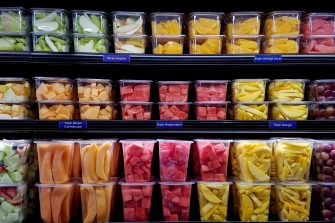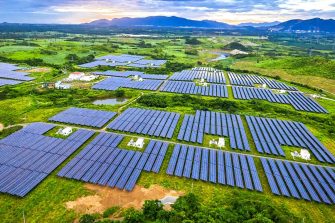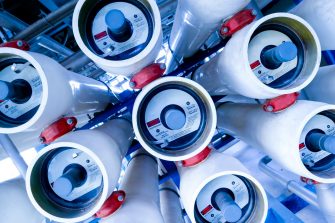Revolutionising biomedical implant materials
Using materials sourced from nature to engineer new and improved implants for cardiovascular patients.

Share this story
As cardiovascular disease continues to be the leading cause of mortality worldwide, the need for more effective treatment options has never been greater. With an ageing population placing additional pressure on organ and tissue demands, as well as the burden of negative cardiovascular outcomes for individuals, communities and the healthcare system – this need is only set to increase. To create better treatment options for patients and practitioners alike, UNSW Associate Professor Jelena Rnjak-Kovacina and her team are working on readily available materials and new material technologies that can be implanted to replace damaged or diseased cardiovascular tissue.
UNSW Associate Professor Jelena Rnjak-Kovacina in her UNSW lab.
Currently, the successful replacement of damaged cardiovascular tissue relies heavily on organ donation or the use of a patient’s own tissue or animal tissue. Each of these options however present a number of challenges and disadvantages, including limited supply and rejection.
For patients undergoing bypass surgery, the stakes are even higher, particularly if they have co-morbidities or damaged vessels. “Someone who is elderly or has diabetes for example doesn’t have many healthy vessels to use,” explains A/Prof. Rnjak-Kovacina. “If you then have to use a synthetic vessel, they pretty much fail most of the time.” Synthetic vessels are particularly troublesome if a smaller vessel like a coronary artery replacement is required. “You can end up with a blood clot or significant inflammation and the vessel closes up again,” says A/Prof. Rnjak-Kovacina.
"That’s why we’re trying to build new blood vessels that can act in place of these implants, and bring in materials that support and integrate with the heart.”
- A/Prof. Rnjak-Kovacina
A web of possibility
One of these materials is a natural silk fibroin protein made by silkworms and spiders. “We’ve been able to isolate silk from the cocoons of the Bombyx mori silkworm and engineer this into new vascular grafts, cardiac patches and heart valve leaflets,” explains A/Prof. Rnjak-Kovacina.
Although there are a range of materials to consider across cardiovascular applications, this particular silk is preferred over many materials already found in the human body that are more difficult to work with. “Silk is abundantly available and well tolerated by our body,” she adds. “It can be made to be super soft or strong, which allows us to mimic complex tissue structures in the body, and importantly, is biodegradable.”
In studying the fundamentals of these new materials, A/Prof. Rnjak-Kovacina and her team are furthering the understanding of how silk and other material properties correlate with biological responses, and how they send signals to the body to either form scar tissue or regenerate healthy tissue. “For a long time, materials were seen as passive scaffolds that only served to support the mechanical function of the damaged tissue or to deliver cells and growth factors that promote healing and tissue regeneration,” she explains.
“We, and others in the field, are increasingly presenting evidence that materials encode very important information in their morphology and mechanical features, and that this can be harnessed to elicit specific biological responses.”
- A/Prof. Rnjak-Kovacina
Cocoons and silk of the Bombyx mori silkworm.
Associate Professor Rnjak-Kovacina and her team. From left to right Katelinh Nguyen, Anne Marie Vuong, Zac Och, Mahsa Haghighattalab, Marija Kordanovski, Jelena Rnjak-Kovacina, Sandra Spoa, Trinh (Judy) Ho, Hien (Henry Tran), Gagan Jalandhra, Nona Farbehi.
Working as one
This field of research relies heavily on the insights and knowledge of a range of collaborators including clinicians and colleagues both locally and abroad. “We are tackling complex problems with serious implications for the patients, so a coordinated multidisciplinary effort is key,” says A/Prof. Rnjak-Kovacina. “Not only do our collaborators understand the clinical problems, they can also speak to integrating the research with other systems as well as the patient experience.”
A/Prof. Rnjak-Kovacina and her team work closely with the clinicians at the Victor Chang Cardiac Institute as well as St. Vincent’s Hospital Sydney and the Royal Prince Alfred Hospital (RPA). She is also supported by UNSW’s IHealthE Institute. More recently, her team has received a grant from NSW Health, which will be applied to research undertaken in partnership with UNSW, The University of Sydney and RPA Hospital.
Through her research, A/Prof. Rnjak-Kovacina has already shown that by changing the microscale morphology of materials, we can potentially change inflammatory responses, blood vessel formation, tissue remodelling and healing. Not only should this contribute to better patient outcomes, but her findings are leading the way for more affordable and sustainable technologies for the treatment of cardiovascular disease the world over.
As the research and its outcomes continue to develop, the potential for a positive impact on a small and large scale is undeniable.
“While our work is targeted towards creating impact for cardiovascular implants, the fundamental materials knowledge and technologies we develop can also be applied more widely".
- A/Prof. Rnjak-Kovacina
Fabrication of silk biomaterials using a microfluidic device. It was taken in the GSBmE labs in 2023.
Share this story
Read more
Get in touch and see what’s possible.
Ask how we can help your business, industry, or market through collaboration.



